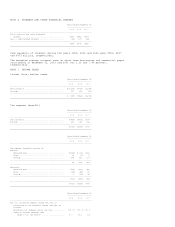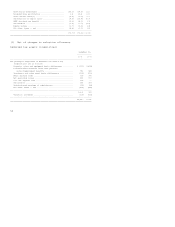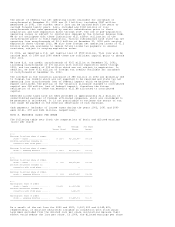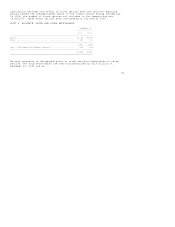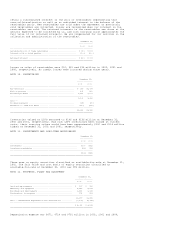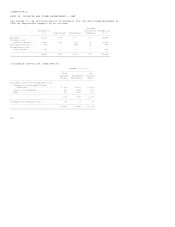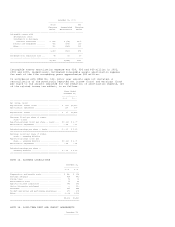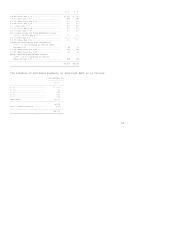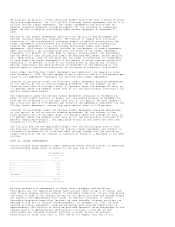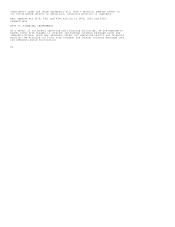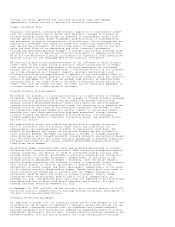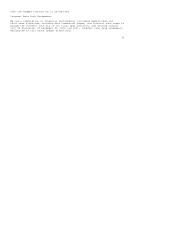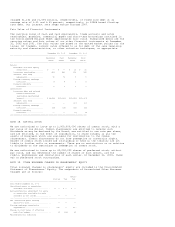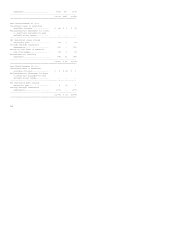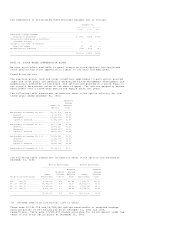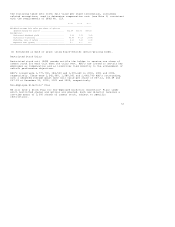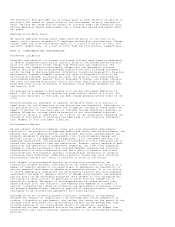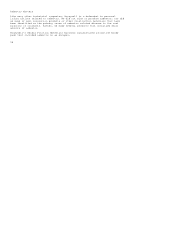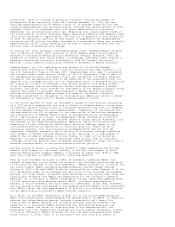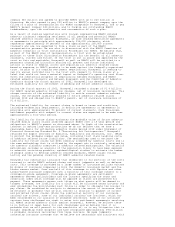Honeywell 2002 Annual Report Download - page 258
Download and view the complete annual report
Please find page 258 of the 2002 Honeywell annual report below. You can navigate through the pages in the report by either clicking on the pages listed below, or by using the keyword search tool below to find specific information within the annual report.through our normal operating and financing activities and, when deemed
appropriate, through the use of derivative financial instruments.
Credit and Market Risk
Financial instruments, including derivatives, expose us to counterparty credit
risk for nonperformance and to market risk related to changes in interest or
currency exchange rates. We manage our exposure to counterparty credit risk
through specific minimum credit standards, diversification of counterparties,
and procedures to monitor concentrations of credit risk. Our counterparties are
substantial investment and commercial banks with significant experience using
such derivative instruments. We monitor the impact of market risk on the fair
value and cash flows of our derivative and other financial instruments
considering reasonably possible changes in interest and currency exchange rates
and restrict the use of derivative financial instruments to hedging activities.
We do not use derivative financial instruments for trading or other speculative
purposes and do not use leveraged derivative financial instruments.
We continually monitor the creditworthiness of our customers to which we grant
credit terms in the normal course of business. While concentrations of credit
risk associated with our trade accounts and notes receivable are considered
minimal due to our diverse customer base, a significant portion of our customers
are in the commercial air transport industry (aircraft manufacturers and
airlines) accounting for approximately 17 percent of our consolidated sales in
2002. Following the abrupt downturn in the aviation industry after the terrorist
attacks on September 11, 2001 and the already weak economy, we modified terms
and conditions of our credit sales to mitigate or eliminate concentrations of
credit risk with any single customer. Our sales are not materially dependent on
a single customer or a small group of customers.
Foreign Currency Risk Management
We conduct our business on a multinational basis in a wide variety of foreign
currencies. Our exposure to market risk for changes in foreign currency exchange
rates arises from international financing activities between subsidiaries,
foreign currency denominated monetary assets and liabilities and anticipated
transactions arising from international trade. Our objective is to preserve the
economic value of cash flows in non-functional currencies. We attempt to have
all transaction exposures hedged with natural offsets to the fullest extent
possible and, once these opportunities have been exhausted, through foreign
currency forward and option agreements with third parties. Our principal
currency exposures relate to the Euro, the British pound, the Canadian dollar,
and the U.S. dollar.
We hedge monetary assets and liabilities denominated in foreign currencies.
Prior to conversion into U.S dollars, these assets and liabilities are
remeasured at spot exchange rates in effect on the balance sheet date. The
effects of changes in spot rates are recognized in earnings and included in
Other (Income) Expense. We hedge our exposure to changes in foreign exchange
rates principally with forward contracts. Forward contracts are marked-to-market
with the resulting gains and losses similarly recognized in earnings offsetting
the gains and losses on the foreign currency denominated monetary assets and
liabilities being hedged.
We partially hedge forecasted 2003 sales and purchases denominated in foreign
currencies with currency forward contracts. When the dollar strengthens against
foreign currencies, the decline in value of forecasted foreign currency cash
inflows (sales) or outflows (purchases) is partially offset by the recognition
of gains (sales) and losses (purchases), respectively, in the value of the
forward contracts designated as hedges. Conversely, when the dollar weakens
against foreign currencies, the increase in value of forecasted foreign currency
cash inflows (sales) or outflows (purchases) is partially offset by the
recognition of losses (sales) and gains (purchases), respectively, in the value
of the forward contracts designated as hedges. Market value gains and losses on
these contracts are recognized in earnings when the hedged transaction is
recognized. Deferred gains and losses on forward contracts, used to hedge
forecasted sales and purchases, were $2 and $1 million, respectively, at
December 31, 2002. The deferred gains and losses are expected to be reclassified
into Sales and Cost of Goods Sold within the next twelve months. All open
forward contracts mature by December 31, 2003.
At December 31, 2002 and 2001, we had contracts with notional amounts of $1,203
and $1,507 million, respectively, to exchange foreign currencies, principally in
the Euro countries and Great Britain.
Commodity Price Risk Management
Our exposure to market risk for commodity prices arises from changes in our cost
of production. We mitigate our exposure to commodity price risk through the use
of long-term, firm-price contracts with our suppliers and forward commodity
purchase agreements with third parties hedging anticipated purchases of several
commodities (principally natural gas). Forward commodity purchase agreements are
marked-to-market, with the resulting gains and losses recognized in earnings


